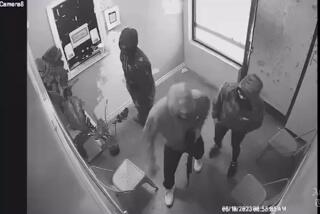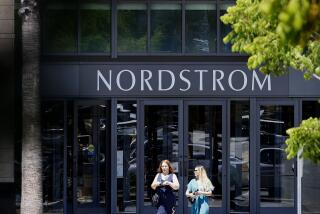LAPD Commander Turned Holdup âBedlamâ Into Order
When the first shots were fired in last weekâs terrifying North Hollywood bank robbery, the top operations officials from the Los Angeles Police Department happened to be having breakfast together at the Auto Club near USC, where the top staff was handing out a set of annual awards.
One by one, beepers began chirping, and word quickly spread through the room that a major incident was unfolding in the San Fernando Valley. Cmdr. Royal Scott LaChasse--the No. 2 LAPD leader in the Valley and one with extensive anti-terrorism experience--turned to his boss, Valley Bureau Deputy Chief Martin Pomeroy, and offered to hurry to North Hollywood. Pomeroy agreed.
By midmorning, LaChasse, a chiseled, 27-year-veteran, had taken command of a sprawling, frightening and complicated situation. According to officers and others who worked inside the command center, LaChasse coolly coordinated the efforts of officers from across the LAPD, as well as firefighters, paramedics, Los Angeles County sheriffâs deputies, FBI agents and others.
Officers poured in from around the city, desperate to help but in some cases unsure what to do. SWAT officers who had been working out at the Police Academy when they heard the news responded so quickly some were still wearing shorts. Radio frequencies crackled with tense, urgent commands. In dispatch tapes released Monday, out-of-breath officers at the scene called for assistance, and the staccato bursts of AK-47s could be heard in the background. A dispatcher called out: âMultiple officers hit. Theyâre sending in a tank for the officers.â An officer shouted: âIâve been hit. Iâve been hit.â Another officer told the dispatcher to warn the air units: âGet some altitude. These suspects are armed with automatic weapons.â
Police at the scene were woefully outgunned. Scores of officers sought details and directions as their commanders struggled to keep track of it all.
âThere was,â LaChasse recalled, âabsolute bedlam.â
LaChasse, who served as incident commander for the event, quickly established a command post in front of a furniture store around the corner from the bank, and from there wrestled control of the LAPD response.
The robbery of a Bank of America branch and its bloody aftermath left 11 officers and six civilians injured. Both robbers--who pummeled officers and a suburban neighborhood with bullets from AK-47s--died in the shootout.
As they sort out the details of the LAPDâs actions during last weekâs chilling robbery, city and Police Department leaders credit LaChasse with helping to restore order and with supervising a heroic series of police efforts.
âNot to take anything away from anyone else, but LaChasse was so cool, so calm, so in charge,â said Police Commission President Raymond C. Fisher. âHe was superb.â
Mayor Richard Riordan also commended LaChasse, as did police officers and others working the command post.
âScott did an exceptional job, just great,â Pomeroy said.
*
There is irony in the praise now being heaped on LaChasse. Until last year, he was a key figure in LAPDâs Headquarters Bureau. But he was transferred to the Valley against his will, a move that many Police Department insiders believed was in retaliation for his leading role in the Command Officersâ Assn., which has been openly critical of Police Chief Willie L. Williams.
In the wake of the shooting, however, neither LaChasse nor the department were interested in rehashing old controversies.
âI think the timing was ill-advised,â LaChasse said of his transfer. âBut itâs like everything else. You donât own the job.â
Cmdr. Tim McBride, the LAPDâs chief spokesman, said that because of the transfer--whatever its merits--the Police Department ended up with the right man in the right place at the right time.
âYou have to have the right guy in that position--and we did,â McBride said. âAs chaotic as it was--the shooting had just stopped--he had assigned all the officers . . . and set up a command post. I marveled at that.â
McBride acknowledged that there had been some hard feelings about LaChasseâs transfer, but he stressed that Fridayâs events showed the value of having top-notch leaders deployed across the city.
âYou put your very best people in your operational entities,â McBride said. âThatâs what happened in this situation.â
The magnitude of the fast-moving situation unfolded on LaChasseâs police radio as he raced to North Hollywood from the awards breakfast.
He heard officers were firing at the suspects outside the bank but that âthey werenât going down.â Then he heard that the suspects appeared to have AK-47s and appeared to be wearing body armor--a combination that suggested the event was highly unusual even in a city that leads the nation in bank robberies.
Arriving at the scene shortly before 10 a.m., LaChasse was debriefed by a North Hollywood lieutenant, the highest-ranking police officer present. At that point, the information was sketchy.
âWe didnât know how many people were involved in the robbery, we didnât know how many officers were wounded or how many were responding,â LaChasse said. âThere was a lot going on simultaneously: a rescue operation, police responding to calls from citizens, two suspects going mobile. People trying to get in and out of the area.â
He started drawing up plans on the trunk of his car, but quickly realized he needed a full-blown command post. The trunk, he said wryly, âwas not adequate.â
At his direction, a few officers canvassed local businesses.
Phil Palagonia, the manager of a furniture store, said employees were working Friday morning with representatives from the companyâs main office. When employees heard shots, they ran to the windows to see what was happening. A police officer yelled to stay back.
Moments later, Palagonia said, an armored truck with detectives and wounded civilians pulled up at the storeâs back door. They asked for blankets; Palagonia gave them thick furniture pads.
When officers asked if they could use the store as a command post, Palagonia didnât think twice.
âIt seemed there was an urgency so I just said, âSure,â â he said. âI didnât call my bosses or anything.â
In addition to space, Palagonia handed over a large map the store uses for deliveries and a smaller map book. Officers conveniently set up in the dinette section.
The store turned out to be a police officerâs dream. Desks and tables gave officers room to spread out and consult maps. Plentiful telephone lines allowed for quick outside communication. A bank of television sets provided instant updates from the hovering media helicopters.
*
Within minutes, LaChasse organized officers into several areas. Some handled operations, others handled planning and intelligence, tactics, investigation, traffic and the medical response.
By 10:30 a.m., the LAPD had an action plan but âthere was no end in sight,â LaChasse said. âWe had to keep planning--is there another suspect? How do we deal with the perimeter? We donât want a suspect to get out with all the civilians trying to leave the area.â
With so many agencies involved, the possibilities for miscommunication were serious. But people inside the command post said LaChasse coolly ordered top LAPD officials--including some who outrank him--to keep tabs on each entity.
âEven with so many people in and out, nobody was arguing,â said McBride, who has observed command posts for the last 23 years and who said this one âwas clearly in the top drawer.â
With more robbers feared on the loose, a plan was established to search the area using LAPD SWAT officers as well as sheriffâs deputies with police dogs.
âIt was a hot zone,â LaChasse said. âWe had a closed area but we didnât know if we still had a suspect.â
Officers were dispatched to ambulances and other emergency vehicles in case escorts were needed for injured police or citizens. Officers also had to be aware that there could still be a âgetaway driverâ in the area. LaChasse told police to allow no one in or out of the blocks ringed by yellow crime tape. Even reporters, who typically can cross police lines, were kept out.
Meanwhile, LaChasse had âa succession of peopleâ coming into the furniture store for briefings. At one point, another officer there said, LaChasse had Mayor Richard Riordan at one elbow and Williams at the other.
When the dogs sniffed out the possible trail of a suspect at a house on Radford Street, LaChasse ordered out the ârescue vehicle,â LAPDâs words for the controversial battering ram.
âThe dogs picked up a scent . . . and we were still looking for a possible suspect,â LaChasse said. âIt looked like a positive hit.â
It was not.
In fact, as detectives interviewed bank employees and customers, they discovered that witnesses recalled different numbers of robbers. Without knowing whether more gunmen might be on the loose, LaChasse said he had no choice but to keep the area closed while air units and officers searched apartments. It was not until dark that the department called off the search for a third or fourth robber.
The delay raised new logistics problems. Children were returning home from school, parents from work. At first, LAPD commanders kept the area sealed. But by late afternoon, LaChasse allowed SWAT officers to escort school police with children and parents back to their apartments.
Time and again, the planning and cooperation between agencies paid off. But any response as complicated as last weekâs has its wrinkles.
In this case, it was food. As the incident dragged on, officers got hungry. A couple officers ordered 100 In-N-Out burgers, but they quickly disappeared. Other officers brought hamburgers and fries from another nearby fast-food restaurant, but that too was gone fast.
Eventually, LaChasse ordered several hundred boxed lunches and charged it to an LAPD account.
âNext time,â he said, smiling, âwe have to think about food.â
More to Read
Sign up for Essential California
The most important California stories and recommendations in your inbox every morning.
You may occasionally receive promotional content from the Los Angeles Times.











